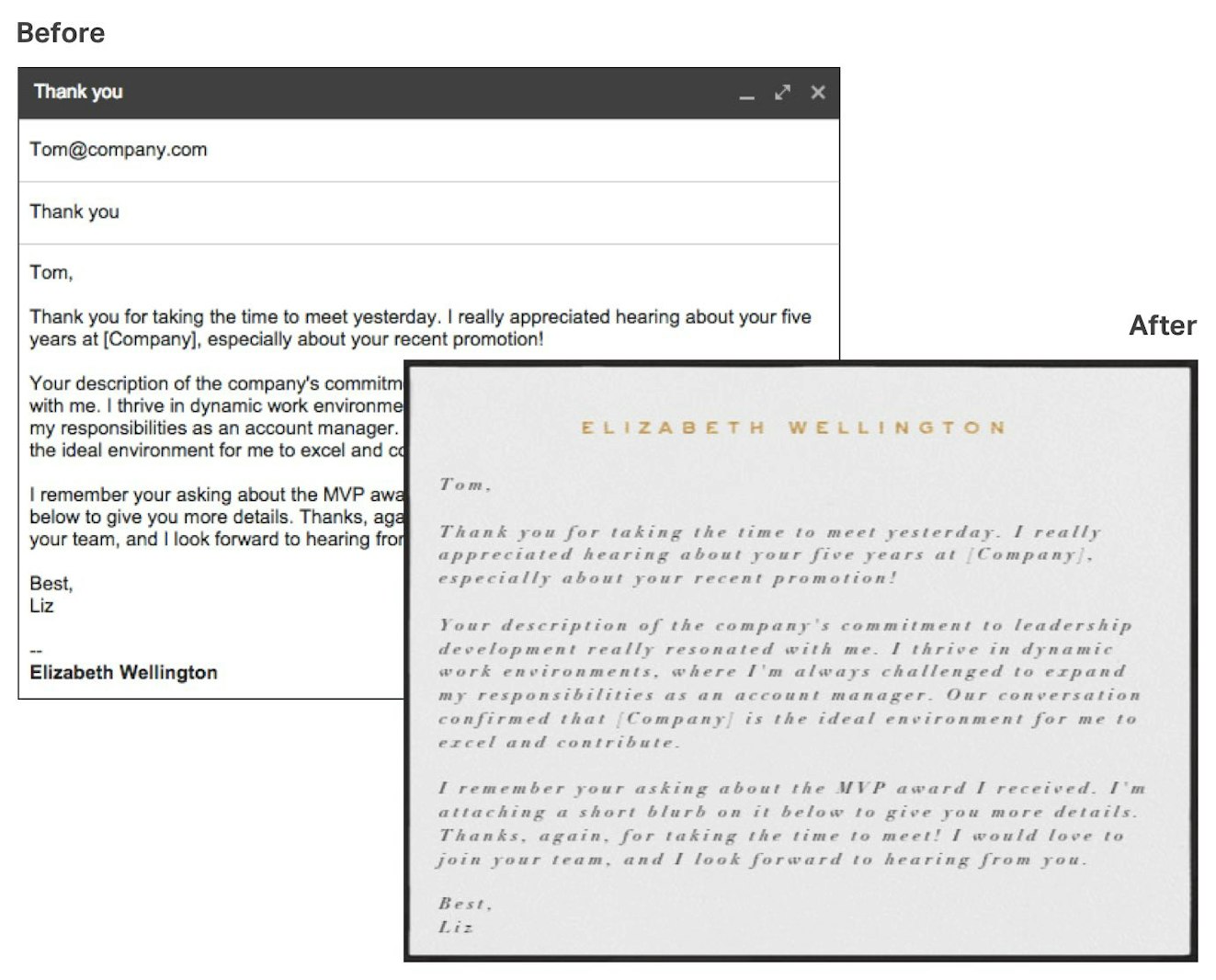Thank-you notes are a must — and not just because your mom says so.
In the age of snappy emails and casual texts, writing a well-worded thank-you note can be intimidating. And knowing that your job prospects ride on it is enough to keep anyone up at night.
A thank-you email after an interview is a reflection of your soft skills: your comfort with expressing gratitude, your willingness to follow through, and your ability to strike a professional and personal chord at work.
Mastering such an important thank-you is both a science and an art. You need the clarity to stick to the rules — keep it succinct and send it in a timely manner — and the finesse to establish a meaningful connection with your future employer.
Here is a detailed look at crafting a post-interview thank-you that’s customizable to your unique strengths and character. You can rest easy now, knowing that when you land an interview for your dream job, your thank-you note will seal the deal.
Emails do the trick
A handwritten letter is a timeless gesture, but it’s not a safe bet because companies expect a quick turnaround. Organizations make hiring decisions fast, and it’s possible the team would make a decision before receiving your handwritten note. With that in mind, write a thank-you note via email. If you’re wincing at the idea of saying thank you digitally, mention that you plan to follow up with a more formal handwritten letter.
You can also take a hybrid approach and send your thank-you via Paperless Post. Their elegant designs bring an extra level of gravity to a post-interview thank-you email without sacrificing the speedy delivery.
Paperless Post’s options include classic thank-yous and online personalized stationery. I like personalized stationery because it reminds interviewers of your name. It only took me a few minutes to create this design below, and you can send it for less than a dollar. With a little bit of effort, you can replicate the charm of to a handwritten note digitally.

Anatomy of a memorable thank-you note
It’s all too easy to plop a name into a post-interview thank-you template — and recruiters know you didn’t write it yourself. If other candidates could have sent your thank-you, it’s not reflective of who you are. Personalization and authenticity are key.
The most effective thank-you notes eschew rambling for brevity and substance. Your note should be two or three paragraphs, with every sentence serving a specific purpose. Rather than giving you a generic template, here’s a breakdown of how to create your own thank-you sentence by sentence:
The beginning
Gauge the company culture and your rapport with the interviewer to choose a greeting. “Dear Alice” can seem too formal for some employers, and “Hey,” “Hi,” or “Hello” may be too informal for others. If you’re unsure, go with the simplest solution: the interviewer’s name and a comma.
Sample Introduction:
Alice,
From there, you want to jump right in with the obvious words.
Sample Sentence 1:
Thank you for meeting with me yesterday.
To seem warm and engaging, mention something about your interviewer (and their organization) before talking about you.
Sample Sentence 2:
I really appreciated learning about how your team is disrupting the marketing industry.
Or something less formal if you have a personal connection with the interviewer.
Alternative Sentence 2:
I was glad to connect with a fellow Buckeye today!
The middle
As you move along, get more specific. Mention something you connected with the interviewer about during the meeting. If you developed a rapport, there will be a few different touch points — pick the most compelling one.
Sample Sentence 3:
I enjoyed geeking out over beta testing with you — it’s rare that someone wants to dig into the intricacies of support in this stage of a product!
If you didn’t build a rapport with the interviewer, you can always harken back to a general topic you both discussed.
Alternative Sentence 3:
It was a pleasure to talk to you about my experience in SaaS customer service; with nine years in the industry, it’s great to meet someone with the same passion for the field.
Now, talk about you. Give a sentence (or two) about what you bring to the organization.
Sample Sentence 4:
I think my background as a support manager at Marketo would translate beautifully to your platform — I know the needs of this customer base, and I enjoy the challenge of helping people navigate a new product in the market.
You could also share some thoughts on a question they brought up during the meeting or link to relevant work.
Sample Sentence 5:
By increasing training efforts and working one-on-one with each team member, I’d be able to decrease the customer service response time, just like I did at my current employer (by 20% this year).
Alternative Sentence 5:
I know you wanted some more detail on my experience as a manager this year — I attached my final presentation on our team’s customer service achievements below.
The end
Thank them one more time.
Sample Sentence 6:
Thank you, again, for taking the time to talk today.
If you want the job, go ahead and tell them!
Sample Sentence 7:
I would be thrilled to work for your organization, and I’m looking forward to hearing from you over the coming weeks.
Keep the sign-off simple.
Sample Sign-Off:
Best,
Avoid the biggest thank you note flubs
Before you click “send,” you need to make sure your thank-you note is polished. Accidentally goofing up is worse than not sending any thanks at all — it can hurt your chances of getting an offer. Here’s a checklist of five ways to avoid the biggest faux pas:
1. Send it within 24 hours
When applying for a position, you always want to show up to interviews on time. Likewise, you always want to send a thank-you email ASAP. Not only is it more likely to give you an edge if it arrives quickly, punctuality reflects well on your character.
2. Match the formality of the employer
A great thank-you note to a finance VP should look different than a note written for a startup. To gauge the formality of the language, look around at the office dress code. If everyone’s wearing suits, your note should be more formal.
3. Make sure they know it’s you
Some people are so nervous they write a thank-you before the interview, keeping it bland and generic. Check your note to make sure you included two references to something specific from the interview or your experience — it helps the company to match a name to the face.
4. Customize each note
If you’re sending a thank-you note to multiple interviewers in the same organization, write a different thank-you card from scratch every single time. If you have writer’s block, follow our sentence-by-sentence guide and write each one out by hand first.
5. Always, always, always proofread
After you’ve drafted and edited your thank-you note, proofread it. Double check to make sure each person’s name is spelled correctly. Now, ask your favorite proofreader to look for glaring — and subtle — mistakes. You can also use a tool like Grammarly, which is a step up from your average spell check. When there’s a fatal flaw like a misspelled name or an incomplete sentence, it can dampen your prospects at the organization.
Writing a thank-you email after an interview can help you hit it out of the park with a future employer. It shows that you have follow-through to connect as a colleague. With these tips, you're bound to deliver an even better note than before. So, next time you need to write a thank-you email, get started sooner rather than later for the best results.







